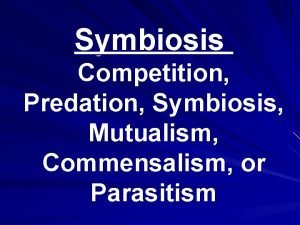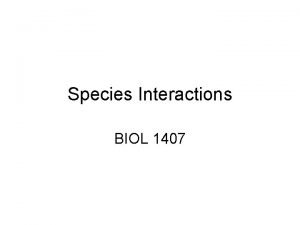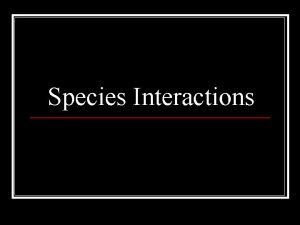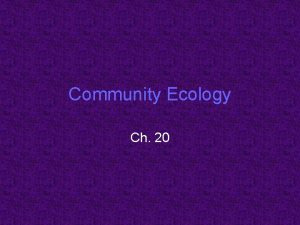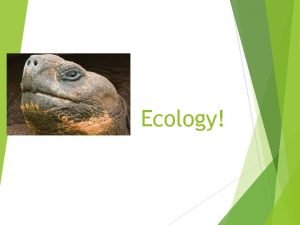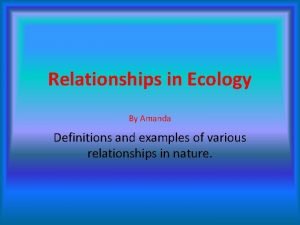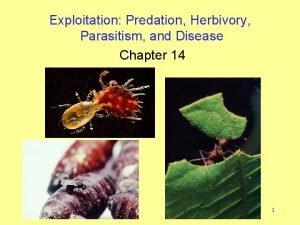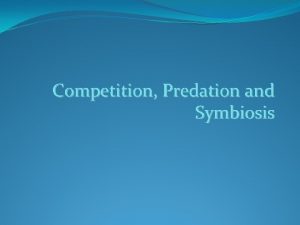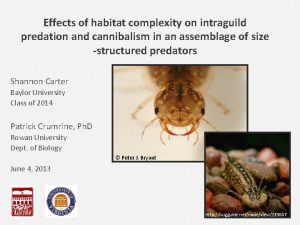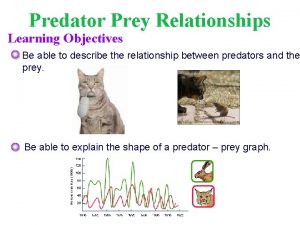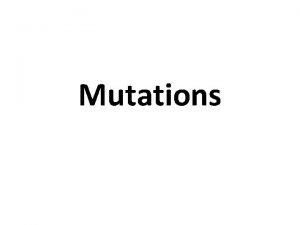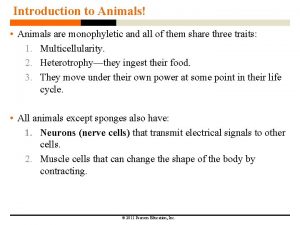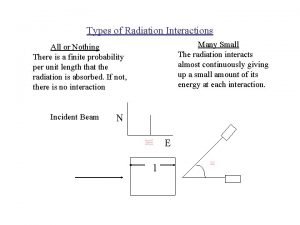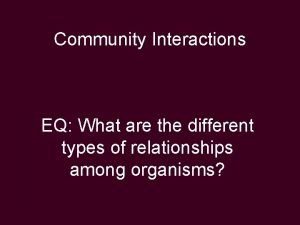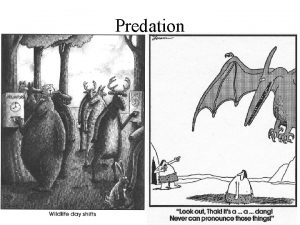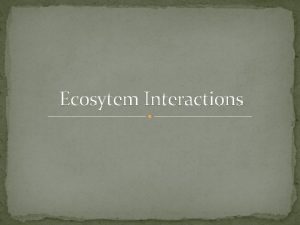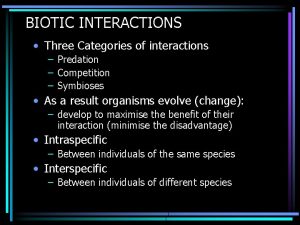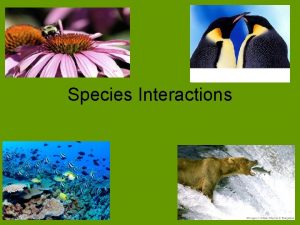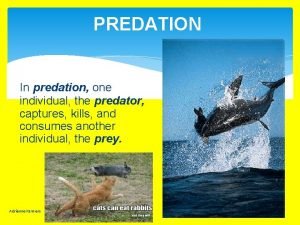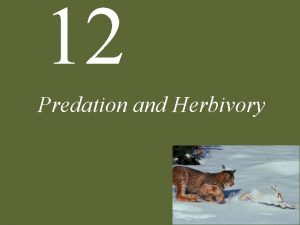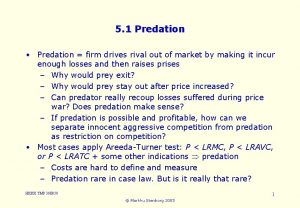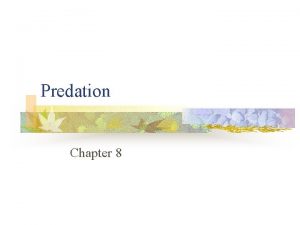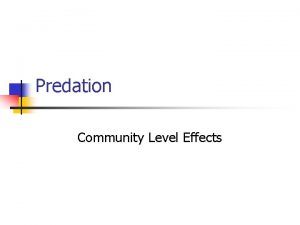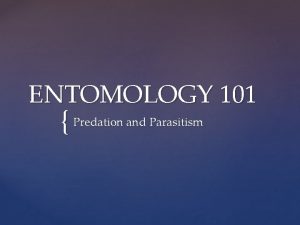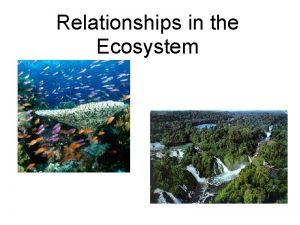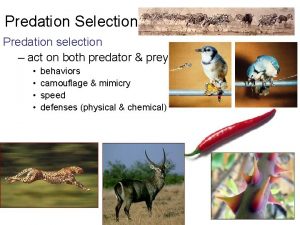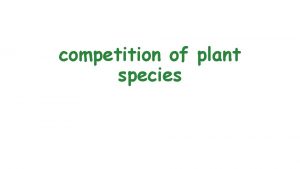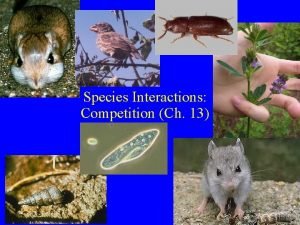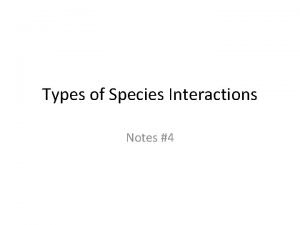Species Interactions Types of Species Interactions Predation Competition





















- Slides: 21

Species Interactions

Types of Species Interactions • Predation • Competition • Symbiosis – Mutualism – Commensalism – Parasitism

Predation • Predation is any interaction between two organisms in which one organism (the predator) consumes all or part of another organism (the prey).

Predator-Prey • Photo Credit: Dr. Kay Holekamp, MSU, http: //hyenas. zoology. msu. edu/hyena/image-gallery. html (Image 13 from Photo Gallery) • Predation can involve one animal eating another animal.

Herbivore-Plant Interactions • An herbivore grazing on a plant is another example of predation. • Usually, only part of the prey is eaten by the predator. • Photo Credit: Rhett A. Butler @ mongabay. com

Prey Defenses • Predation usually results in the evolution of defensive adaptations in prey. • These can include: – Chemical defenses (toxins, poison, acrid sprays) – Behavior (living in groups, scouts, alarm calls) – Morphological features (spines, color, structures that allow you to run fast or detect predators), and other traits • Photo Credit: Rhett A. Butler @ mongabay. com

Competition • Competition in an interaction between two organisms that are using the same limited resource. • Competition can be within the same species (intraspecific) or between different species (interspecific).

Example: Interspecific Competition • Two species of barnacles on rocky coasts often compete for space. • The smaller species (Chthamalus) is unable to compete as well as the larger species (Balanus). • However, Chthamalus can survive drying better than Balanus, so it can live higher up on the rocks.

Example: Interspecific Competition • A small Chthamalus barnacle is circled in red. • A large Balanus barnacle is circled in blue. • Photo Credit: Department of the Interior

Symbiosis • Symbiosis is an intimate relationship between different species in which at least one species depends upon the relationship to survive.

Types of Symbiosis • Mutualism: Both partners benefit from the relationship (win, win) • Commensalism: One partner benefits from the relationship; the other partner is not affected (win, meh) • Parasitism: One partner benefits from the relationship; the other partner is harmed (win, lose)

Example of Mutualism • Acacia ants live in acacia trees. • The tree provides big hollow thorns as a home for the ants and provides food for the ants in yellow swellings on the leaves (red oval).

Example of Mutualism • The ants defend the tree against herbivores, both large and small. • They attack insects and large grazing herbivores.

Example of Mutualism • The ants also clear an area around the tree of competing vegetation. • Without the ants, the acacia tree cannot compete with other trees.

Example of Commensalism • Cattle egrets are often found around grazing herbivores, such as these African buffalo or cattle in Texas fields.

Example of Commensalism • The cattle egrets eat insects that are flushed as the big herbivores move around. • The herbivores get no benefit or harm from the egrets. • Photo Credit: Noodlefish @ flickr. com

Example of Parasitism • Songbirds are often heavily parasitized by ticks. • The birds are often anemic, stressed and more vulnerable to predation. • Photo Credit: Bill Hilton, Jr. @ hiltonpond. org

Example of Parasitism • Fungal parasites often infect living organisms, such as plants, animals or other fungi. • This shelf fungus releases enzymes to digest the wood of this tree, which weakens the tree and makes it more vulnerable. • Photo Credit: BIOL 1407 Student

Coevolution • Coevolution occurs when two species evolve in response to one another. • For example, predators evolve in response to prey defenses. Prey evolve in response to predation.

Coevolution • Mutualists and parasites coevolve with their hosts. • Pollinators coevolve with the flowering plants they pollinate. • Photo Credit: Mike Sykes

Homework • Animal Paragraph • Write a paragraph about the relationship between your animal and other species AND how your animal relates within it’s own species. • Is it predator, parasite, mutualist………etc. • Is it solitary and very territorial, does it live in a colony……etc. ?
 Symbiosis predation
Symbiosis predation 5 types of symbiosis
5 types of symbiosis Parasitism pictures
Parasitism pictures Cape buffalo and cattle egrets relationship
Cape buffalo and cattle egrets relationship Section 20-1 review species interactions
Section 20-1 review species interactions Habitats niches and species interactions worksheet
Habitats niches and species interactions worksheet Symbiosis and species interactions keystone webquest
Symbiosis and species interactions keystone webquest Characteristic of monopoly
Characteristic of monopoly Perfect competition vs monopolistic competition
Perfect competition vs monopolistic competition Monopoly vs oligopoly venn diagram
Monopoly vs oligopoly venn diagram Perfect competition vs monopolistic competition
Perfect competition vs monopolistic competition Predation examples
Predation examples Predation vs parasitism
Predation vs parasitism Parasitism
Parasitism Predation
Predation Predator examples animals
Predator examples animals Predation examples
Predation examples Difference between predation and parasitism
Difference between predation and parasitism Gary polis
Gary polis Keystone species plants
Keystone species plants Types of interactions
Types of interactions Parasitism
Parasitism
